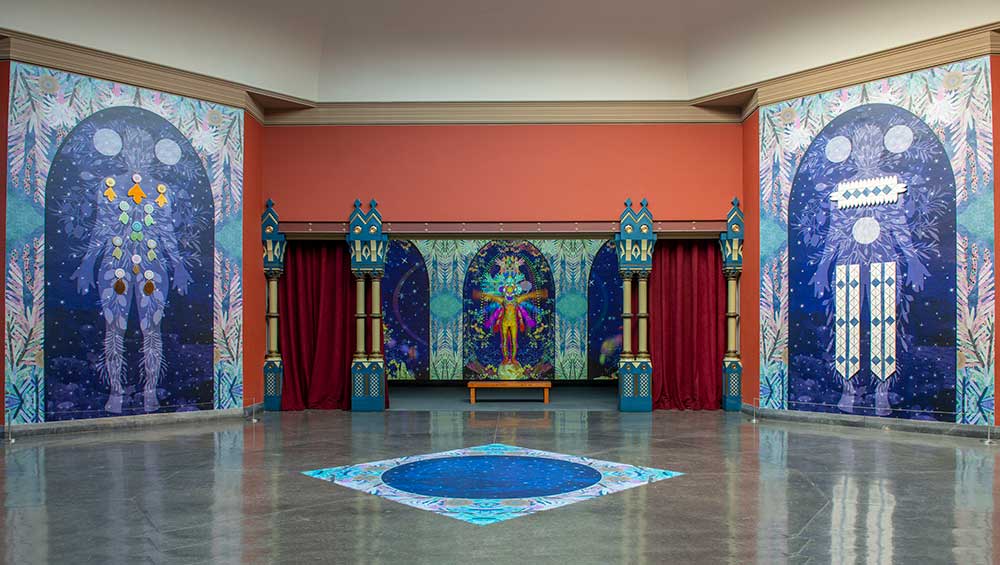
Saya Woolfalk. We Emerge at the Sunset of Your Ideology, 2022. (installation detail view). Multimedia installation, four figures: glass and digital collage vinyl mural, 214 x 145 inches each. 2 single-channel colour videos, infinite loop with sound. Pennsylvania Academy of the Fine Arts. Photo: Lori Waselchuk.
Pennsylvania Academy of the Fine Arts and the African American Museum in Philadelphia
3 March – 8 October 2023
by LILLY WEI
In an unprecedented, timely, but complicated partnership, the august Pennsylvania Academy of Fine Arts (PAFA), the oldest art school and museum in the United States, and the much younger African American Museum in Philadelphia (AAMP), founded in 1976, are co-sponsoring the exhibition called Rising Sun: Artists in an Uncertain America. The idea of a joint exhibition was the brainchild of Jodi Throckmorton, PAFA’s curator at the time (she is now chief curator at the John Michael Kohler Arts Center in Sheboygan, Wisconsin), its completion at the academy overseen by the independent curator Judith Tannenbaum. Throckmorton then brought her idea to Dejay Duckett, vice-president of curatorial services at AAMP, to discuss a possible collaboration.
Throckmorton was inspired by the story about Benjamin Franklin and the chair that George Washington sat in during the Constitutional Convention in 1787 (it is in the show.) It has a sun carved on its back divided by a horizontal line and Franklin said at the conclusion of the convention: “I have often looked at that picture behind the president without being able to tell whether it was rising or setting. But now at length I have the happiness to know that it is a rising and not a setting sun.” Duckett, in turn, responded with James Weldon Johnson’s Lift Every Voice and Sing, the de facto Black national anthem written in 1900 and of this line in particular: “Facing the rising sun of our new day begun.”
Together, Throckmorton and Duckett commissioned a diverse selection of 20 cross-generational artists across a range of disciplines – some heavy hitters, some a little less so – to address the pressing question about the state of democratic values in the grievously polarised US: is it a rising or setting sun? The uncertainty about the state of US democracy was further roiled by the bumpy, nearly four-year period leading up to the exhibition’s opening that included Black Lives Matter and the chaotic Trump presidency, exacerbated by a global pandemic that wreaked havoc everywhere, the subtext that has leached into the exhibition for artists and viewers alike, even if not directly stated.
At AAMP, all the artists are Black, as mandated: John Akomfrah, La Vaughn Belle, Mark Thomas Gibson, Martha Jackson Jarvis, Demetrius Oliver, Dread Scott, Renée Stout, Hank Willis Thomas and Deborah Willis. At PAFA, there is Eamon Ore-Giron and Wilmer Wilson IV. The majority of the artists, however, are women: Shiva Ahmadi, Petah Coyne, Tiffany Chung, Lenka Clayton, Dyani White Hawk, Alison Saar, Rose B Simpson, Sheida Soleimani and Saya Woolfalk.

La Vaughn Belle. Between Dusk and Dawn: Navigating an Unsettled America, 2023. 1 channel video, 7 min 29 sec. Courtesy of the artist. Installation view, Rising Sun: Artists in an Uncertain America, African American Museum in Philadelphia. Photo: Constance Mensh for African American Museum in Philadelphia.
The presentations at the much smaller AAMP are more tightly interwoven, intimate, in conversation with each other, partly because of their proximity but also because of very specific shared concerns, however individualised. These works are focused on Black bodies, Black lives, Black experience and history. Belle’s lambent panoramic video installation, projected along the long wall of a ramp leading upward to the galleries, benefited, like much of the show, from the ingenious, less orthodox solutions required by the museum’s architectural limits (which should be expanded when it moves into its future home close to Philadelphia’s Museum Mile.)
A lilting, deceptively lovely film, it shows the sun rising and setting on St Croix, the artist’s home and Guam, the two furthest points of American territorial dominion, with echoes of the former British boast that the sun never set on its far-flung empire. Scott weighed in with photographs that are re-enactments of actions such as stills from the Slave Rebellion, a performance, and the recasting of the iconic image of Huey Newton seated regally, militantly in a rattan peacock chair by an arresting, similarly armed female guerrilla fighter in the central role.
.jpg)
Renée Stout. Hoodoo Assassin #13 (the Chameleon), 2021. Acrylic and ballpoint pen on paper, 8 x 8 in. Courtesy of the artist.
Stout said that her cadres of powerful, ecumenical Hoodoo Assassins, an ongoing series, are her imagined protectors, patrolling her fantasy of a more just world, and Gibson sweetened (if that’s possible) the bitterness of his subject with a perky animatronic daisy, blooming out of a dirt mound that is a Klansman’s grave, marked by a tombstone, to the swell of music.
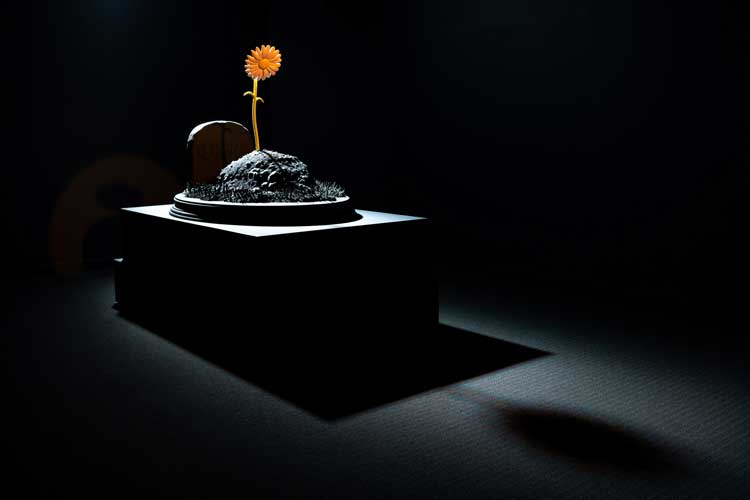
Mark Thomas Gibson. Their Failure is Our Reward, 2022. Animatronic flower, gypsum cast grave,
speakers and wood base. Music performed by Ethan Philbrick and Rashonda Reaves, 43 ¾ x 60 x 45 in. Installation view, Rising Sun: Artists in an Uncertain America, African American Museum in Philadelphia. Photo: Constance Mensh for African American Museum in Philadelphia.
At PAFA, with much larger and more elaborate galleries, its own collection taken down for the first time to make way for Rising Sun, the artists were given room to expand – and they did. The installations were ambitious and visually compelling, each project akin to a one-person show. The veteran artists Saar and Coyne strutted their stuff with operatic, virtuosic flair. In Hygiea, named for the goddess of health, but also of hygiene and its handmaid, cleanliness, Saar created a constellated magical kingdom. It is a tribute to workers, focusing on cleaning women, who are largely of colour and largely invisible, here given primacy.
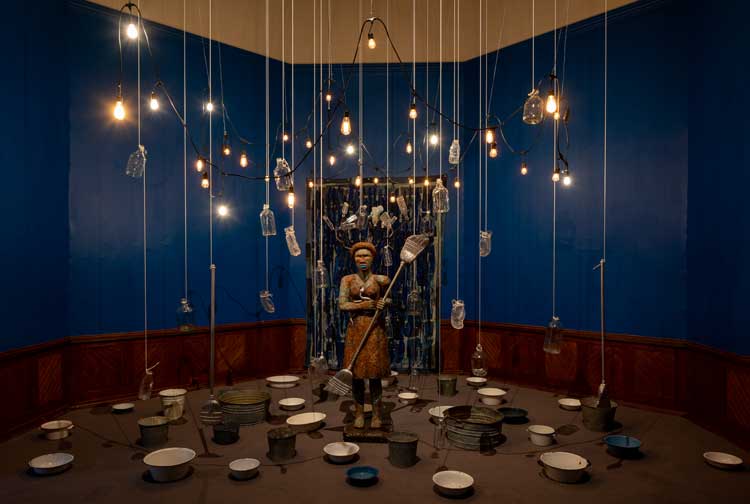
Alison Saar. Hygiea, 2020. Mixed media installation with sound. Commissioned by PAFA for Rising Sun: Artists in an Uncertain America, courtesy L.A. Louver.
The stalwart, even heroic figure, mop proudly in hand, boldly confronts the viewer, surrounded by the attributes of her craft – bottles, pails, other implements – transformed by light into gilded precious objects (which during the pandemic they became).

Petah Coyne. Untitled #1383 (Sisters—Two Trees), 2013–23. Pennsylvania Academy of the Fine Arts. Photo: Lori Waselchuk.
Coyne’s bi-level installation is gorgeous, as always. Sisters-Two Trees is a full-scale blackened apple tree created from two entwined trunks, a pride of white peacocks roosting on its widespread branches, representing her generation, while up a small staircase built expressly for the viewing, you can peer through an opening in the ceiling to see clusters of luxuriously waxed flowers suspended overhead in a vast skylighted space (all named after accomplished females) and an additional pair of peacocks. Called The Color of Heaven, it signals a new, more promising dawn, particularly for women.

Petah Coyne. Skylight level: Untitled #1551 (Color of Heaven), 2021–23. Pennsylvania Academy of the Fine Arts. Photo: Lori Waselchuk.
Among the younger artists, Woolfalk’s challengingly – although also confidently – titled We Emerge at the Sunset of Your Ideology, commands the enormous heart of the exhibition space that she has transformed into a crosswalk or a public square of sorts, the ceiling to floor multimedia, multidisciplinary work continuing to explore the nature of human bodies and their transformative potential. She conceives of a new kind of reality peopled by her imagined, more beneficent beings.
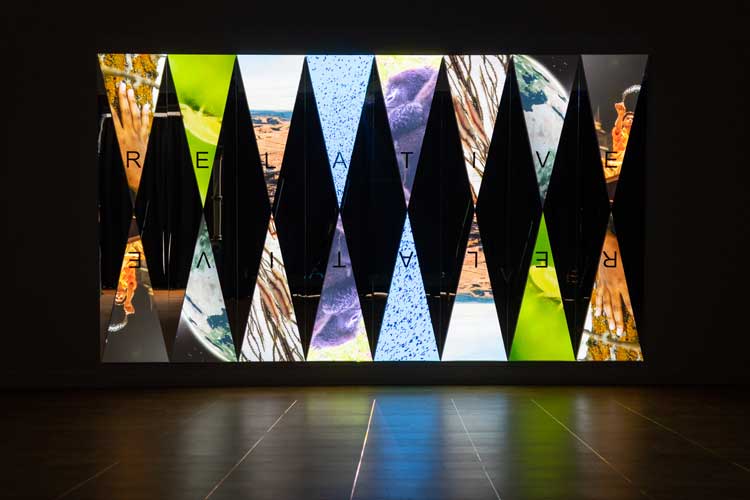
Dyani White Hawk. Relative, 2023. Vinyl on mirror glass panels, 8-channel video, colour, 6-minute loop, sound composition, stereo, 20-minute loop, 9 x 16 ft. Commissioned by PAFA for Rising Sun: Artists in an Uncertain America, courtesy of the artist and Bockley Gallery.
White Hawk’s Relative, also multidisciplinary, its eight-channel video with sound, sprang directly from the Johnson anthem and is an exultant, comprehensive tribute to interconnections of all kinds in a contemporised hopeful vision of the US today.
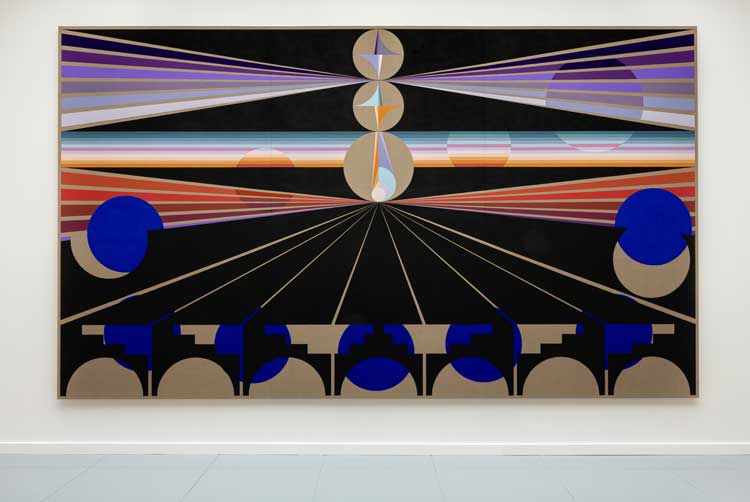
Eamon Ore-Giron. Black Medallion XV (Mama-Quilla), 2022-23. Mineral paint and Flashe on linen, 14 1/2 x 25 ft. Commissioned by PAFA for Rising Sun: Artists in an Uncertain America, courtesy of the artist and Fleisher/Ollman, Philadelphia.
Ore-Giron’s two enormous abstract paintings face each other across the main staircase that leads to the principal galleries and recall Al Held’s monumental futurist geometric paintings. Ore-Giron’s cosmic landscapes are light and dark, one representing dawn, the other dusk, a cyclical rising and setting that so far has succeeded each other without fail. It might be noted that behind them, hidden by a temporary wall, are the Benjamin West paintings that have long held court there, an actual pairing of past, present – and future.
This first effort to forge a meaningful partnership between art institutions of disparate missions and unequal standing and resources has produced a notable exhibition. It will be no easy task to continue to do so, although the process of exploration and experimentation itself is a plus and could result in invigorating new modes of curating and of exhibitions that will be representative and of benefit to everyone. Who would not want to say that in the US, in the world, it is a rising and not a setting sun, that a new day has begun?